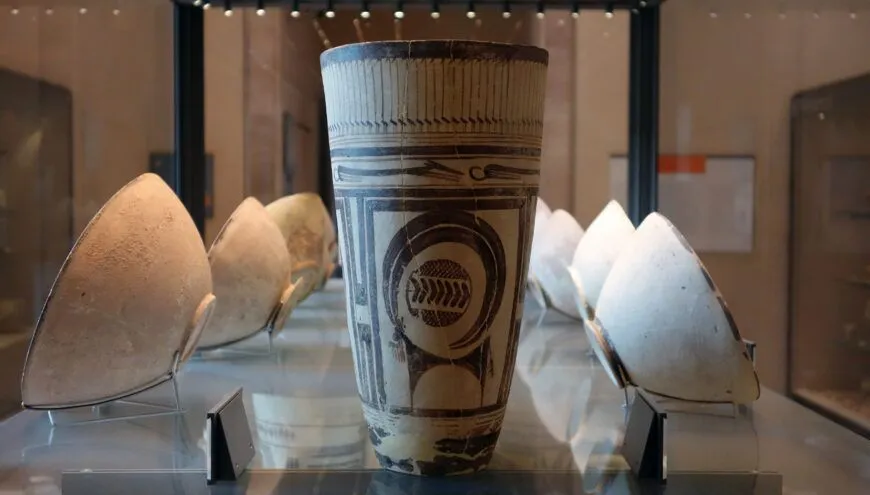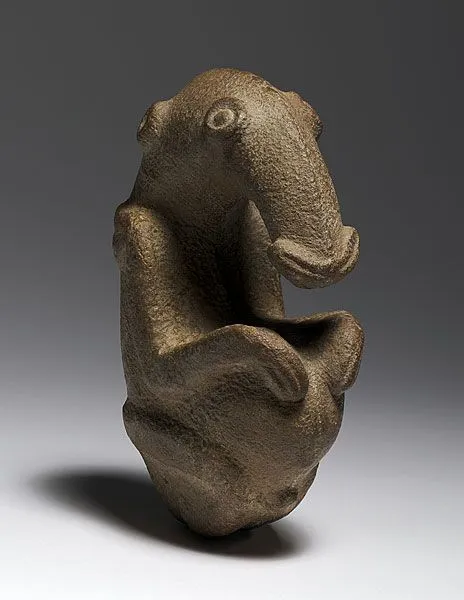APAH UNIT 1
1/10
Earn XP
Description and Tags
AP Art History Unit 1
Name | Mastery | Learn | Test | Matching | Spaced |
|---|
No study sessions yet.
11 Terms

Apollo 11 Stones
Namibia
25,500-25,300 BCE (Paleolithic/Middle stone age)
Charcoal on hand sized quartzite depicting feline creature in twisted perspective, but mainly in profile.
Found in a religious site in the Huns Mountains because of shamanistic beliefs in supernatural animals.

Great Hall of the Bulls
Lascaux, France
15,000-13,000 BCE (Paleolithic/Middle Stone Age)
Planned out rock painting of charcoal and ochre on white calcite (dots, dashes, and mouth-blown)
Twisted perspective (body in profile, head head-on)
Homosapien + Neanderthals coexisted
Big + small halls, stone tools, branch scaffolding, animal fat lamps
Repetitive redrawing as ritual to ensure successful hunt.
Shaman human interacting with nature.

Camelid sacrum in the shape of a canine
Central Mexico
14,000-7,000 BCE
Carving of camelid sacrum bone, associated with fertility in Mesoamerican cultures, into canine figure
Unknown purpose or date due to unprofessional excavation

Running Horned Woman
Algeria
6,000-4,000 BCE
Pigment on rock in a sanctuary of the goddess in a canyon on a plateau
Outstretched limbs, curved breasts, grain cloud, dancing clothes, scarification, destroyed from excavation

Bushel with ibex motifs
Susa, Iran (southern Mesopotamia)
4,200-3,500 BCE
Painted terra cotta
Buried with the dead under temples
No records of religious or spiritual purpose
Animal motifs representing fertility and water (Ibex, dog, birds)
Made of registers, emphasizing geometry

Anthropomorphic Stele
Arabian Peninsula
3000s BCE
Carved Sandstone
Stylized grave marker demonstrating spread of knowledge and regional artistic differences.
Temporary settlement
Holding a dagger, 3 ft tall

Jade Cong
Liangzhu, China
3,300-2,200 BCE
Carved Jade
Process was difficult and expensive (status symbol)
Found in lavish tombs in tools and ornaments placed by the dead
Facial motifs
Square cross-section and circular hole representing the divide between the Earth and the sky

Stonehenge
UK
2,500-1,600 BCE
Sandstone
3 stones arranged in trilithons (post and lintel)
Small stones are blue stones that came from 225 km away
Antlers used as picks
Sarsen stones line the outer ring
Early astronomy (relating to agriculture and yield)
Pilgrimage and feast on winter solstice where the setting stone lines up with the arch of the trilithons and promises another spring

The Ambum Stone
Ambum Valley, Papua New Guinea
1,500 BCE
Hand-carved greywacke, pleasing shape and patina
Stylized anatomy
Used as a pestle and religiously significant (life of its own)
Taken by missionaries

Tlatilco Female Figurine
Central Mexico
1,200-900 BCE
Ceramic + paint
Elaborate hair (represented fertility)
Emphasized torso, wide hips and spherical thighs
Other ceramic figures were of the local lake area or of priests in costume
2-faced representing duality

Terra Cotta Fragment
Lapita population
Solomon Islands
1000 BCE
Incised Terra Cotta made with stamped patterns (of people) and white coral paste
Food serving and storage
Demonstrates movement of people in the Pacific Islands from Taiwan to Oceania